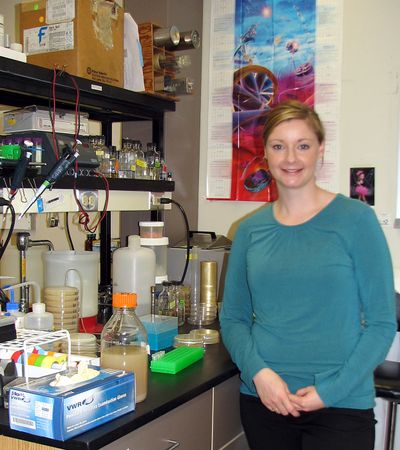UI student keeps busy with research, daughter

University of Idaho senior Amy Winegardner went on a white-water rafting trip in 2006 along the Selway River – it was the summer she says, before she moved to Moscow, Idaho, to pursue a degree in microbiology.
Amid friends from Coeur d’Alene, Winegardner enjoyed moving at the pace of the river and indulging in the outdoor activity – something she had always treasured growing up in a small town in Idaho.
Today Winegardner’s study subject, a bacteria known as Myxococcus xanthus, keeps her moving at a faster pace. She says she works better under stress – Winegardner is currently working on four projects, one of which was funded by a 10-week, $5,000 fellowship from the Institutional Development Award Network of Biomedical Research Excellence
This summer, she studied a protein called MglB related to the coordination and motility abilities of the bacterium. Winegardner fluorescently tagged the protein and then tracked its movements within the cell using time-lapse fluorescent microscopy.
“It’s thought to be a regulator of another protein called MglA, which is a GTPase. This GTPase in turn coordinates both adventurous and social motility.”
GTPases, or guanine triphosphates, make up a family of enzymes that can hydrolyze or break GTP down into its component parts. The research could be especially revealing due to MglA’s link to a family of proteins involved with cancer. M. xanthus research also poses the potential for antibiotic development, as it secretes several molecules known to have inhibitory and antibiotic effects on other microbes, Winegardner says.
Knowing more about MglB and the bacterium’s motility can help with those studies. In adventurous motility, cells of the bacterium generally glide independently of each other. In social motility, cells communicate via pili – tiny appendages bacteria can use to connect themselves to other bacteria – to glide as a group of cells. In this process, pili attach to another cell and are then disassembled inside the cell as it pulls itself toward the other one.
Winegardner balances school with family. In between classes and time in the lab, Winegardner focuses on her 4-year-old daughter, Kallysta.
“Study time of course is a little more limited since I can’t study until after she’s in bed but you know… I have fun with her in the afternoons and after she goes to bed I study. A lot of people try to use it as a sob story but I think it’s been a blessing,” she says.
Winegardner plans to return to her country roots after she completes school. She grew up in Rathdrum, where She first developed her dream to provide care to residents with limited access to medical care.
“I would say that people in small towns definitely need access to better health-care options. A lot of people can’t even make it to a facility to receive care, so they put it off until it’s a lot of times, too late or they’re going to lose a limb or that sort of thing,” she says. “I think creating access to smaller communities would be one of the great things about being a physician assistant.”
Winegardner is a transfer student from North Idaho College in Coeur d’Alene. After being accepted to nursing school, Winegardner fell in love with a general microbiology course in 2005 and transferred to UI in 2006 to pursue a major of the same – her older sister had already followed a similar plan.
But Winegardner hoped to pave her own path. She won the UI Microbiology, Molecular Biology and Biochemistry Department’s Spring 2008 poster competition. She was also a nominee for the department’s outstanding junior award.
Winegardner is involved in three other research projects in addition to her INBRE fellowship. One will be conducted over the course of the next academic year to study results from a scientific paper suggesting that inhibiting the pigment produced by Staphylococcus aureus results in the inhibition of the bacterium’s virulence. This would allow the immune system to reduce or stop infection.
M. xanthus contains a similar gene that leads to pigmentation. The study will try to reveal the mechanism by which genetically identical colonies of a strain exhibit different appearances. A majority of colonies are bright yellow in color and have a “notched” edge. A second type of the same strain produces tan pigmentation and shows globular edges. The study is funded by the Continuing Undergraduate Research Scholar award Winegardner recently won.
And in addition to several other new projects, Winegardner doesn’t often run into people that refer to her as “another Winegardner” anymore.
“I thought it was cool to make a name for myself rather than rely on what my sister did here,” she says.
Winegardner applied to Idaho State University’s physician assistant program this past semester. She plans to graduate from the University of Idaho in May.
The Idaho INBRE program was established through a five-year, $16 million grant from the National Institutes of Health. It is charged with the task of increasing biomedical research conducted in Idaho in addition to improving research opportunities for faculty and students at all of the state’s universities and colleges.